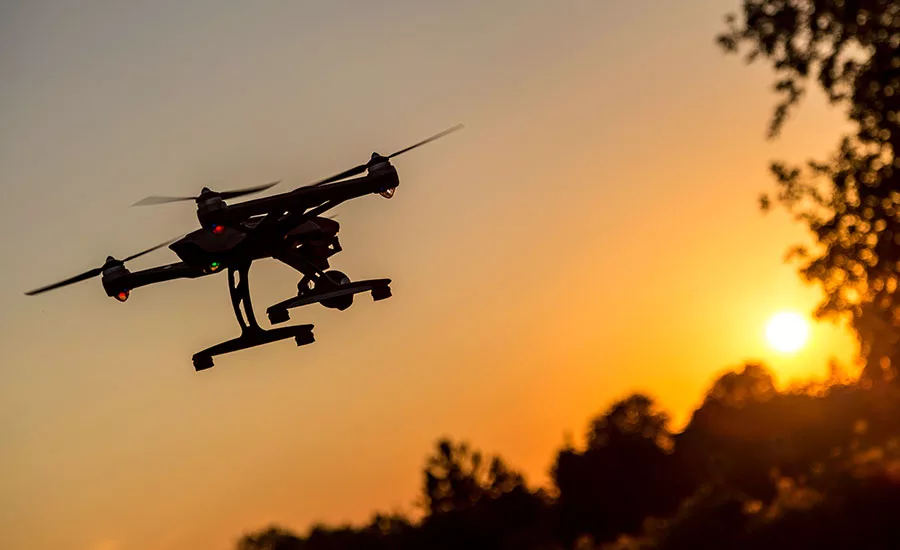Before You Pull the Trigger: The Legal Implications of Shooting Down a Drone

It’s a scenario that isn’t hard for security professionals to imagine: Someone spots a drone hovering inside your secure facility’s perimeter, over your event, or during your emergency response operation. The drone’s presence is at best a nuisance, and at worst, might damage people or property, or interfere with your principle mission. What options do you have?
The kneejerk response from most is, “shoot it down.” But that’s where things get complicated. There is no shortage of counter-UAS technology on the market, should you want to look for something beyond the old-fashioned shotgun, but the question of legality should be considered well before you take aim.
The FAA considers unmanned aircraft of any size to be covered under Title 18 of the United States Code 32, which describes “sabotage to include destruction of any aircraft in the special aircraft jurisdiction of the United States.” Violation of this code carries a maximum prison sentence of 20 years. In other words, it’s illegal to shoot down any aircraft in the U.S., including a drone, according to federal law. And lest you decide that simply jamming or intercepting control of the offending drone might be more your style, know that the FCC considers any form of “jamming” or otherwise interfering with radio transmission to be a violation of the Communications Act of 1934. Between these two federal laws, most anti-drone technology on the market (including net guns and jamming guns) could put you into some legal hot water.
This leaves little wiggle room for local law enforcement, first responders and security professionals when trying to mitigate the potential threat posed by an intruding drone. In a few states, such as Louisiana and Utah, police and firefighters have been granted local authority to disable drones flying over wildfires or endangering the public, but those who act on the basis of these state laws still find themselves in direct conflict with federal regulations.
There is certainly momentum toward a more unified regulatory environment that will allow law enforcement to act in reasonable ways to protect people and property, but until regulation catches up with technology, the best solution to combat an unwanted drone is a mix of prevention and employment of well-planned techniques, tactics and procedures (TTPs if you’re in the military). Here are five things you can do today within the bounds of the law:
- Raise awareness about “no-drone” zones that may exist around facilities or events. Signage explicitly stating restrictions will make a negligent hobbyist less likely to fly where they shouldn’t, and clearly stated restrictions might make any anti-drone actions more defensible in the eyes of the law.
- Include active monitoring for UAS in security plans. If cameras or personnel are already monitoring perimeters, entrances or sensitive points, add awareness of airspace to the mix. The first step in mitigation of potential malicious drones is detection.
- Work with a company capable of identifying and/or classifying any drones spotted in your airspace. Though radio waves cannot be legally used to down a drone, it is admissible to scan an aircraft to determine its intent. Databases exist that can categorize hobbyist versus commercial models, and, if a drone is registered, ownership can potentially be traced.
- Employ counter-UAS drones. This might sound counterintuitive, but military squadrons often defend airspace by flying defensive tactics that do not include firing weapons, and there are companies offering similar capabilities with drones. These “friendly” drones can detect and ID intruding UAS from the air, and can help locate operators by tracking intruding drones back to a landing point. At that point, a handoff with local law enforcement is possible.
- Plan with local law enforcement for worst-case scenario contingencies. There may be a case where authorities are willing to risk legal complications to preserve people or property, and a plan must be in place prior to an incident, so you’ll know what to do if and when disabling an intruding drone is absolutely required.
Because regulations are evolving and differ by locality, take the time to learn what laws apply in your specific locale. Until regulations catch up with UAS technology, providing security that includes a counter-drone plan can feel a little like policing the wild west. Smart planning and partnership with the right counter-UAS partners or technologies for you can keep your property and people safe.
Looking for a reprint of this article?
From high-res PDFs to custom plaques, order your copy today!



